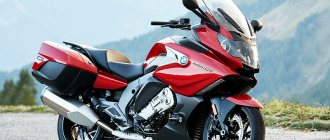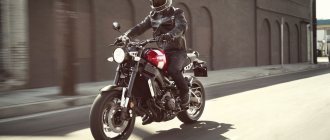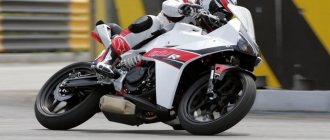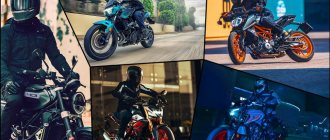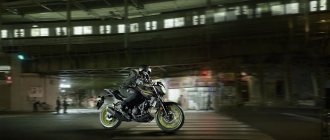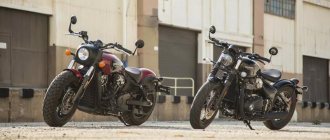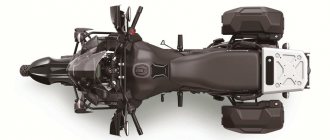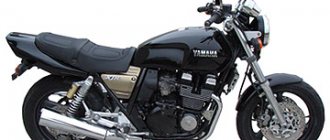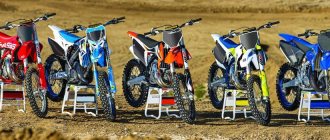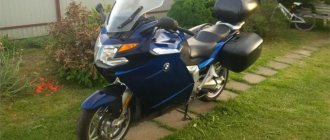Comparison of six 900 nakeds
Have you noticed, but the number of naked bikes with a working volume of up to a liter is constantly increasing. And that's great! Apparently, manufacturers realized that naked bikes over a liter are too big, too fast, too powerful, stuffed with electronics - and too expensive. For those who need a light and fun motorcycle at a reasonable price, something smaller is enough.
If you remember, something similar has already been released, but it was about slightly younger models, roughly 600-700 cc. Today there is another six, mostly richer furnished and with a volume as close as possible to a liter. So, BMW F 900 R, Ducati Monster, Kawasaki Z900, KTM 890 Duke, Triumph Street Triple R and Yamaha MT-09 are the six interesting models in the sub-liter category. Unfortunately, the Suzuki GSX-S750 did not make it here, but, to be honest, it still would not have been in the top three.
So, six motorcycles, three testers, several days of testing on picturesque roads and tracks, including small ones. The asphalt here is not only twisty, but also quite lumpy in places, which puts a lot of work on the suspension and chassis components. Plus some highway, some city, in order to feel the engine’s operation in different modes.
Each tester ranked the bikes they tested from sixth to first place, taking into account several objective and subjective categories. Then we take the overall rating and get the final distribution. For one of the trio, the distribution of places completely coincided with the final one - but it is far from a fact that any other tester would have placed the places in the same order. But here's the overall rating:
Radio engineering beginning
The Ducati company was founded in 1926 in Bologna. The founders of the company were brothers Adriano and Marcello Ducati. Both of them were interested in radio engineering, so the first direction of the company’s work was the production of radio equipment. In the 20s of the 20th century, the demand for horns and loudspeakers did its job, and the company developed well.
After World War II, the demand for radio equipment fell sharply, and the company came under state control. At that time, the creation of cheap means of transportation was important for Italy, so Ducati's activities were retrained to produce vehicles.
Ducati Monster 2021
Places: Second - fourth - third
Ducati Monster 2021
This Monster has a fresh redesign, so it was all the more interesting what it costs. Appearance is a subjective matter, but still it is a Ducati - the right color, with the right posture, very impressive and attracts attention on the streets. And if you think broadly, then the absence of a cage frame is to his benefit, it’s just a pity that you can’t also get rid of the radiator of the cooling system - it would look even cooler.
At first, the Ducati Monster 2021 is somewhat reminiscent of Kawasaki - in some tastelessness, or something. But unlike Cava, the longer and harder you ride Dukas, the more you start to like it. Its power and thrust curves are, plus or minus, similar to the rest of the five (at medium speeds), but a rather elegant 187kg (with a full tank, the second lightest in this test!) makes it extremely nimble in shifts.
The motorcycle seems narrow and compact, with a sporty character - but this is a Ducati, they are all like that. Typically for Ducati, it is stuffed with electronic chips, and they work much better than others. The bi-directional quickshifter is perfect, the TFT display is the second coolest after the BMW, with excellent navigation on it, and the traction control (which was not really needed due to the wonderful weather) is one of the best in its segment.
Why then third place? Because old Ducati family ills have surfaced, which they seemed to have gotten rid of. For example, heat from the exhaust. It's not as terrible as the powerful Panigale firebox, but it's still pretty annoying. Besides, as great as Monster is, the two ranked above him are simply even better. But, in fact, its main disadvantage is the price - it is the highest in comparison. If you don't take money into account, Monster is one of the best options.
It looks great, has an upright riding position and a soft seat, and handles great. Both brakes have a little more travel than we would like, but they provide excellent braking force. In addition, it rushes well at medium speeds. A chic set of electronics based on an inertia measurement device, everything is customizable, even wheelie control. And there is even launch control, although it is not clear why.
As for the price, the Ducati Monster 2021 is far from the most expensive totem in the Ducatist cult, but they want a decent amount of money for it. And hence the question: how to feel about the fact that the black headlight frame has faded and turned yellow as if it had stood for 20 years under the bright sun?
The suspension on Dukas is soft - not in terms of handling, but in terms of comfort, like the seat. And it's good for long runs. The 937cc L-twin is a great engine in its own right, but compared to in-line twins with a 270-degree crankshaft, it seems a little outdated. It lacks a little punch at the low end and doesn't respond as sharply to the throttle as a KTM or even a BMW. Promoted - superior to BMW, but still not up to Ryzhiy.
Pros of Ducati Monster 2021:
- Likes it rough
- Lightweight and handles great
- On-board electronics
Cons of Ducati Monster 2021:
- Hot
- Expensive
- Cheap plastic in places
Start of motorcycle production
The first production products were engines, designed by engineer Aldo Farinelli. As soon as Farinelli returned to designing sports cars, Ducati celebrated its rebirth. Their first velomobile was called Cucciolo (Russian puppy), and differed from existing velomobiles on the market with an engine capacity of 50 cc. see and excellent traction at low speeds.
Already in the early 1950s, Ducati conquered half of the Italian motorcycle market. By this time, light motorcycles were becoming increasingly popular. And already in 1952 the Cruiser model was released. The new motorcycle was equipped with an engine with an electric starter. With an engine capacity of 175 cc. see the motorcycle's power was 8 liters. With. The only negative was the automatic transmission, since at that time they could not evaluate it properly. But a little later, 3-speed Cucciolo with an engine capacity of 55 cc appeared on the market. see and Cruiser with a volume of 98 cc. cm. These were the first motorcycles that had a telescopic fork, a spinal frame and a rear swingarm.
A little later, Ducati decided to try their hand at sports and released the 98 Sport model. The first sports model accelerated to 95 km/h with a power of 6.5 hp. With.
BMW F 900R 2021
Places: Fifth - sixth - sixth
BMW F 900R 2021
Usually you feel a little uneasy when you put a motorcycle in last place in the ranking, although you understand that in any comparison there must be both a leader and an outsider. At the same time, according to the results of the calculation, the outsider is not always at least in some way a bad motorcycle that deserves to trail behind. But this time it’s normal, without much torment. The strengths of the BMW F 900 R 2021 are its low price and excellent TFT display, but when driving, these points do not play the most important role. The Brembo brakes on it are also quite decent, but they are decent on all other motorcycles, and the difference between them is negligible.
The 895cc inline-two is weak compared to all but the humble Triumph, and even worse, none of the sounds reaching your ears from the engine or exhaust are pleasing to the ear. One of the testers deigned to say that BMW sounds like an evil tractor - and he is not far from the truth. The complete absence of any semblance of a quickshifter is bad, although the gearbox as such on the F900 is quite decent.
The seating position on the 2021 BMW F 900 R is bad and strange: high, forward footpegs, low and distant steering wheel - you end up sitting in a clothespin position. Maybe they turn so fiercely in their Alps that they need huge angles of inclination? No, it’s clear that naked bikes are motorcycles for dynamic riding, but you shouldn’t sacrifice comfort.
Yes, during dynamic driving, the BMW's stance is justified - it is even more cheerful than its modest characteristics suggest, and from about 6000 it rushes quite well, and the suspensions handle bumps decently. But for truly exciting sports driving it is too heavy and long, and at the same time the least powerful of the six. And it is best suited as a sports tourist for people with long arms and short legs. Well, or you need to ride it for longer than a few days to get used to it. Then, perhaps, you will even be able to figure out how to reset the tripmeter on this built-in tablet - the instrumentation here is futuristic and quite informative, but you also need to get used to it first.
And you know, this “you have to get used to it” spoils the whole attitude, because otherwise the motorcycle is not bad. It feels expensive and of high quality, the engine pulls from the bottom and produces traction progressively, although compared to other 900s (except Kawasaki) it feels somewhat slow-moving. However, it plays out quite easily on moderately sharp turns - it can’t match the maneuverability of lighter motorcycles, but its calm nature allows it to go through a series of convolutions at a smoother pace. In general, when you get used to it a little, it is quite pleasing - for example, on the highway, but in the city the landing is still terrible.
Pros of the BMW F 900 R 2021:
- Brakes
- TFT tidy display
- Beautiful coloring
Cons of the 2021 BMW F 900 R:
- Sounds like a tractor
- The engine runs out of steam quickly
- Footrests
Fabio Taglioni period
And in 1954, the young engineer Fabio Taglioni became the chief designer. The main achievements of Ducati are associated with him. His first motorcycle was a Ducati 100 Gran Sport with a 98 cc engine. The riders immediately liked it. Fabio sought to increase engine power by increasing speed. By placing the camshaft in the cylinder head, the engineer was able to achieve 9 horsepower. With. and 9,000 rpm, which allowed a motorcycle weighing 80 kg to reach speeds of up to 130 km/h. The desmodromic drive with a mechanism for forced opening and closing of valves, developed by Taglioni in mid-1956, appeared on the new motorcycle model only in 1958. The single-cylinder engine of this motorcycle was 125 cc. see. And the next year Ducati released a similar motorcycle, only with a two-cylinder engine.
But this is all for sporting purposes; for the domestic market, Ducati produced motorcycles with 175 and 200 cc engines. cm. And already in the early 60s, a new generation motorcycle was created - Ducati 250 (18 hp, 4 strokes, overhead camshaft). Motorists easily increased the engine capacity of this model to 450 cc. The most efficient models with a 250 cm³ engine were the Mach 1 of 1964 and the Mark 3D of 1968.
Taglioni later began developing a 1,300 cc engine for the US government. The result was a 4-cylinder engine (100 hp) Apollo. But at that time, tires suitable for such power had not yet been created, so its use had to be abandoned. True, in the Ducati 750GT motorcycle (1970), Fabio installed a simplified version of this engine with a volume of 750 cc. cm. This model could accelerate to almost 200 km/h with a weight of 185 kg and an engine of 60 hp. A similar Super Sport 750 motorcycle with desmodromic drive accelerated to 215 km/h. These technologies made it possible to win first places in motorcycle racing year after year.
But Taglioni went further, he replaced the camshaft from bevel gears with a toothed belt, and in the manufacture of cylinders he used an aluminum alloy with a nickel-silicon coating instead of cast iron. Around this time, the famous Ducati frame made from chrome-molybdenum steel tubes, similar to a birdcage, appeared.
In 1979, Ducati released the 500 Pantah, this model was the fastest with an engine capacity of 500 cc. cm.
In the 1980s, the company experienced a crisis. In 1985, the competing and successful motorcycle concern Cagiva bought out the production of Ducati motorcycles and began producing enduro-style motorcycles based on Ducati two-cylinder engines.
Kawasaki Z900 2021
Places: Sixth - third - fifth
Kawasaki Z900 2021
As you can see, there was no unanimity among the testers: while for two this model was clearly at the bottom of the rating, for the third it was successful. Despite the largest engine displacement of the six, Kawasaki is in second place in terms of power (and it is inferior to the smallest engine, Triumph). But in terms of torque it has an honest first place. The character of the engine is very pleasant, linear and smooth, and another nice feature is the rather modest price.
And all this would be good, but the trouble is that otherwise the 2021 Kawasaki Z900 is an absolutely unmemorable motorcycle. All that can be said about him, good or bad, is to remain silent. He seems to be doing everything right, and that’s the whole problem. The engine pulls, the suspension works, and everything else behaves as it should, but it lacks some zest (or spice). Character, in general.
There are also a couple of more objective complaints: even for a quite normal height of 170 cm, the seating position on the Kawasaki is somehow cramped. The comfortably low saddle is let down by the usual height of the footpegs, which causes your knees to touch your elbows, and the handlebars are narrow, which only aggravates the feeling of cramping. Perhaps replacing the saddle with a higher one would be better, but in stock form the Z900 is designed for small people.
But you know, it's amazing how different people have different views on the same aspects. I will give the opinion of the second expert who put the Kawasaki Z900 2021 in third place:
I liked this model from the very release, and since then my love for the Z900 has only grown. Its inline four has a pleasant, soft character, unlike many sports fours. It produces 2,500 rpm more bottom-end torque than any other of the six, and then gradually builds up power almost on par with the leader in this department, Triumph, only it produces it at 9,600 rpm, like the Monster's V-twin. Moreover, the Monster’s torque is always lower than that of the Kava. As a result, we have a wide, smooth wave of power that only derated Japanese fours can provide. And thanks to Kava for this!
The performance numbers won’t tell you anything about how this heavy (second heaviest) motorcycle turns - it’s so fast and light on the move, so compact, apparently thanks to the correct weight distribution with forward cylinders and a horizontal rear shock absorber - just a sportsbike in the style of transformers. For long-distance riders, the saddle is thin and not too soft, but it’s easy to change, but you don’t get tired of the engine at all (it runs smoothly, doesn’t jerk or vibrate), and your hands on the grips don’t go numb.
In short, all Kawasaki has to do is release the Z900 SE with cruise control and top-end suspensions to make things really good.
Pros of the 2021 Kawasaki Z900:
- (Almost the most) smooth and powerful motor
- Low seat
- Looks interesting
Cons of the 2021 Kawasaki Z900:
- Spineless
- Close fit
- Inconvenient navigation on the dashboard
Massimo Bordi's period and the present time
Just in 1985, after the retirement of Fabio Taglioni, the position of chief designer was taken by Massimo Bordi. Based on Pantah engines of 350, 750 and 904 cc. see single-seat sports models Ducati 350F3 and 750F1, touring Ducati 350/750 Paso, and Ducati Super Sport were produced. From this moment on, Ducati begins its cooperation with the Italian company Termignoni, the manufacturer of exhaust systems.
The Ducati 916 debuted in the early 1990s. The design of the motorcycle was done by Italian designer Massimo Tamburini, who created the design of a number of Bimota motorcycles, as well as the MV Agusta F4 and Brutale. It had a small feature - a cantilever rear wheel suspension with a front suspension in the form of an inverted telescope fork.
In 1992, designer Michel Galuzzi created the legendary Monster model. It had a two-cylinder L-shaped engine with two-valve cylinder heads and air-oil cooling. The next step was the Ducati 748 and Ducati 916 motorcycles, their engines had Desmoquatro valve actuators, liquid cooling and fuel injection.
In 2000, the Testatretta model appeared. During its development, every part of the engine was computer processed to reduce weight and increase strength. An even more advanced engine with a capacity of 135 hp was developed in this way. With. (10200 rpm) was installed on the new Ducati 996R model.
In 2012 the company was purchased by Audi AG
Triumph Street Triple R 2021
Places: fourth - fifth - fourth
Triumph Street Triple R 2021
It seems like we were recently singing the praises of Street Triple, but now we’re putting it in fourth place. Yes, it's an R model (rather than the top-end RS), but the differences are subtle. It's a fun, enjoyable bike, but compared to the top three, it's a little dated. Well, or outdated.
It's impossible not to fall in love with the howl of the Triumph inline-three and its character. The 765 cc “baby” on the dyno produced more power at peak than all the others - 109.2 hp, but this peak falls almost right at the cut-off of 12,000. And frankly, for a road motorcycle, revving the engine at the cut-off is bad manners. Unsurprisingly, peak torque of 71Nm is the lowest of the group. To Triumph's credit, its thrust curve is almost perfect, but it's lower than the others.
The Street Triple R has the most solid chassis of all six - stable on straight lines, on a slope, when braking, excellent handling, the landing is ideal for dynamic driving, and the sound of the engine on the verge of cutoff is very moody. Eh, if he didn’t have to turn so high, if he had a reserve after the peak, he would be a much better road runner. Apparently, Triumph tried to squeeze the maximum out of the smallest engine compared to its competitors (it is 125 cc less than the next largest engine), and compared to others, it feels like it is working at the limit where others still have reserves. This is noticeable even by how much it vibrates at high speeds.
Triumph's sporty riding position has its fans, but most naked bikes are just for the sake of not hunching over, but enjoying a comfortable riding position when riding through pleasant weather. Triumph, in this regard, is a more traditional naked bike - as if the fairing was removed from the sports bike, leaving the sports pegs where they were, and replacing the clip-ons with a low handlebar, which you still have to reach for. That’s why driving on long highway straights is absolutely not relaxing, you have to transfer weight to the grips, and they also vibrate. Probably, for those who live in Germany and can drive on the autobahn without speed limits, such a landing will be a plus, as well as for spirited driving on winding roads, especially given the traditionally balanced Triumph suspensions. There are no questions about the brakes either, and the presence of a quickshifter is a big plus for such driving and a significant advantage over the Z900 and BMW. But among the top three winners we still had models that were newer in terms of approach.
Pros of Triumph Street Triple R 2021:
- Great chassis
- Engine sound
- Power and thrust curves are amazing
Cons of Triumph Street Triple R 2021:
- Sports ergonomics are not for everyone
- The most powerful in numbers, but not in practice
- Better than the worst and worse than the best
Are Ducatis suitable for beginners?
It's quite common to hear new and/or aspiring riders ask if Ducati motorcycles are the right bike to start their two-wheeled career, and the short answer is "absolutely not." It would be unwise to learn to drive from a modern Lamborghini, and Ducati motorcycles are no different, except for the fact that you have much less physical protection. Even Ducati's non-superbike models are still too big, heavy and powerful to be suitable for beginners.
Despite having a fairly extensive model range, the current range of Ducati bikes is not suitable for beginner riders. The Scrambler and Monster 797 models are great choices for a new rider. Ultimately, the only truly beginner-friendly model in Ducati's current range is the Scrambler Sixty2, which is preceded by a 399cc air-cooled Desmo L-Twin version.
Scrambler
Modern Ducatis boast features such as a rain mode that limits power by around 50%. This really allows you to properly learn and grow as a racer. Ducatis come with traction control and ABS, which also helps in speedy learning. Plus, even with a modern suite of electronics, big bikes aren't forgiving of things like harsh throttle inputs and harsh handlebar inputs.
Learning to ride a motorcycle doesn't just mean understanding how to operate the motorcycle itself, but also doing so in traffic, surrounded by distractions and inattentive drivers. In fact, learning to drive on the road is a skill in itself. By initially riding a smaller, more controllable bike, you'll be able to focus on the road without having to worry about controlling the bike's power. By starting with a smaller size, you can also learn to control it better, develop strong muscle memory, and learn how to drive safely and responsibly.
A large selection of motorcycle accessories, equipment, and spare parts can be viewed via the link on Yandex.Market.
Yamaha MT-09 2021
Places: Second - first - first
Yamaha MT-09 2021
What happened unexpectedly! It seemed that first place should rightfully belong to KTM - and he almost got it. But the Yamaha MT-09 had its own plans for this, supported by an updated 890 cc three.
The old 847 engine was good - but not that good. The new engine, like the KTM, is ready for the race and readily responds to the gas - at any angle of its opening. Unlike the last MT-09, without twitching or kicking - Yamaha has adjusted the fuel maps of the previous MT, resulting in a smooth, powerful, tractable three that makes all the right sounds and spins just right. It's damn impressive - so much so that it outshines the rest of the engines.
In terms of power figures, the MT-09 is in third place: 105.8 hp, but in terms of torque it has caught up with the Kawasaki, exactly the same 85.1 Nm, only available at 7000 rpm, and not at 8100. The graph shows some dips at the bottom , but in real life you don’t notice them, and in general the Yamaha impresses with its handling both during quiet and dynamic driving.
When it comes to spirited riding, all three experts agreed that the Yamaha is second only to the KTM in terms of handling and suspension, but the Orange is a very strong contender, so there's no shame in that. The 9's chassis is much stiffer than the flimsy chassis of the smaller MT-07, but not as sharp and crisp as the Duke's. It’s nice and unexpected that the fork on the MT-09 comes with a full range of adjustments, but the joy is somewhat dampened by the rear shock absorber without compression adjustment, only preload and rebound. However, for a mid-size rider, punching the rear suspension on pavement will be an almost impossible task.
The Yamaha MT-09 2021 is also good in a quiet ride: a wide, soft seat allows you to change the seating position, the seating itself is vertical, with a conveniently located steering wheel and excellent visibility. The TFT instrumentation is not bad, but does not reach the level of Ducati or BMW, but the on-board electronics package is based on an inertia measuring device and includes traction control with tilt angle tracking, slide control, ABS and wheelie control. But all this pales somewhat against the background of how obedient and pleasant the motorcycle is in simple riding. For example, how smartly, clearly and seamlessly does the quickshifter work - and all this at a magical price? Guys, if you were able to make a budget motorcycle like this, then we expect an R9 from you as soon as possible.
Remember, it was mentioned above that you need to compare the basic versions? Yamaha also has an “improved” version - SP - which has more serious suspension and cruise control. But while driving, you don’t think that the basic version is cut down in any way: the engine is gorgeous, it sounds great, the gears shift clearly and clearly, it pulls at any speed with a slight tendency towards the middle and a peak around 7000.
In general, a good naked bike is not only about dynamics and a sporty fit, it is also about the convenience of everyday driving, and appearance is also important. With a new aluminum frame and motor, the new Yamaha MT-09 simply steals hearts - including the quality of finish, appearance, character. In a spirited ride on bad roads, it is slightly inferior to the KTM, but only slightly (plus the ability to adjust the suspension). In the city and on the highway, the Yamaha is a little more comfortable, ergonomics and seating are a little more versatile, and the one-piece saddle provides complete control in aggressive maneuvers, but allows you to change your seating position on the fly on long stretches without difficulty or steps.
Pros of Yamaha MT-09 2021:
- Gorgeous motor
- Technologies
- Price
Cons of Yamaha MT-09 2021:
- Slightly less precise handling than the KTM
- No cruise control
- When will R9 be out?!

